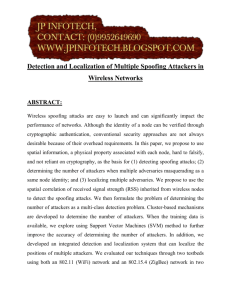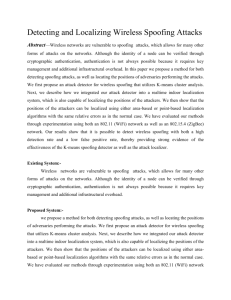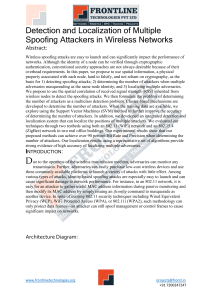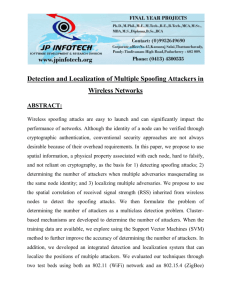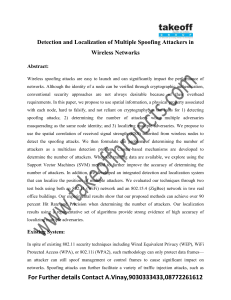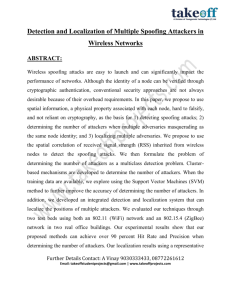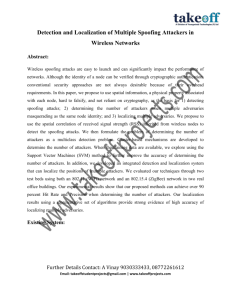Detection and Localization of Multiple Spoofing Attackers in Wireless Networks P.Venkteswarlu
advertisement
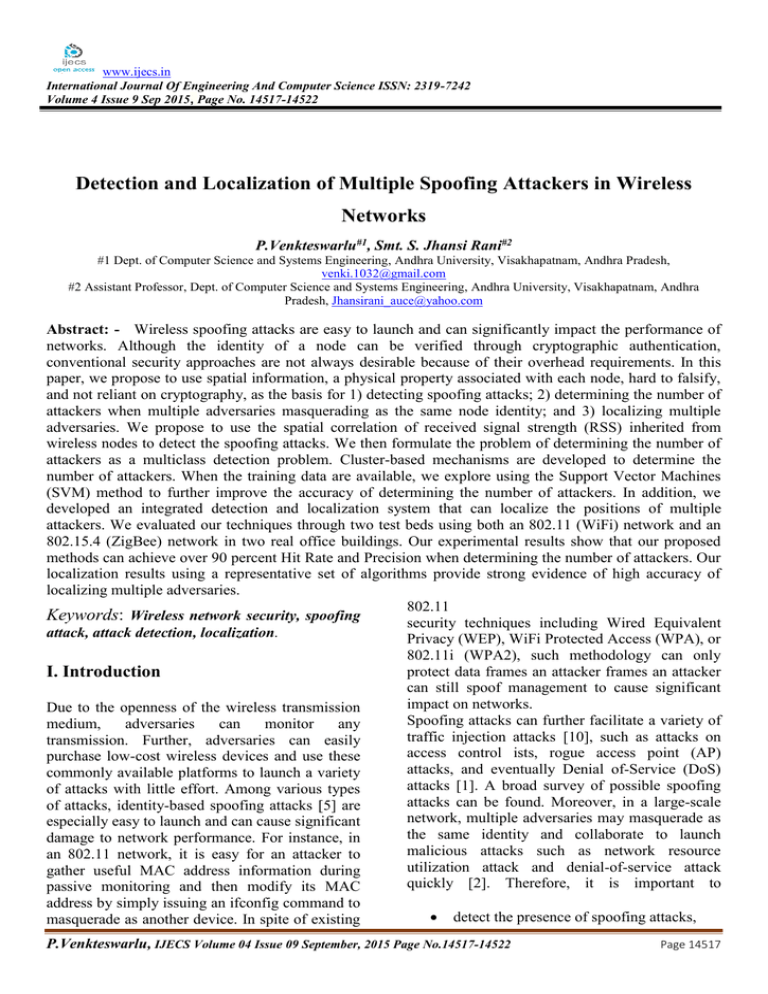
www.ijecs.in
International Journal Of Engineering And Computer Science ISSN: 2319-7242
Volume 4 Issue 9 Sep 2015, Page No. 14517-14522
Detection and Localization of Multiple Spoofing Attackers in Wireless
Networks
P.Venkteswarlu#1, Smt. S. Jhansi Rani#2
#1 Dept. of Computer Science and Systems Engineering, Andhra University, Visakhapatnam, Andhra Pradesh,
venki.1032@gmail.com
#2 Assistant Professor, Dept. of Computer Science and Systems Engineering, Andhra University, Visakhapatnam, Andhra
Pradesh, Jhansirani_auce@yahoo.com
Abstract: - Wireless spoofing attacks are easy to launch and can significantly impact the performance of
networks. Although the identity of a node can be verified through cryptographic authentication,
conventional security approaches are not always desirable because of their overhead requirements. In this
paper, we propose to use spatial information, a physical property associated with each node, hard to falsify,
and not reliant on cryptography, as the basis for 1) detecting spoofing attacks; 2) determining the number of
attackers when multiple adversaries masquerading as the same node identity; and 3) localizing multiple
adversaries. We propose to use the spatial correlation of received signal strength (RSS) inherited from
wireless nodes to detect the spoofing attacks. We then formulate the problem of determining the number of
attackers as a multiclass detection problem. Cluster-based mechanisms are developed to determine the
number of attackers. When the training data are available, we explore using the Support Vector Machines
(SVM) method to further improve the accuracy of determining the number of attackers. In addition, we
developed an integrated detection and localization system that can localize the positions of multiple
attackers. We evaluated our techniques through two test beds using both an 802.11 (WiFi) network and an
802.15.4 (ZigBee) network in two real office buildings. Our experimental results show that our proposed
methods can achieve over 90 percent Hit Rate and Precision when determining the number of attackers. Our
localization results using a representative set of algorithms provide strong evidence of high accuracy of
localizing multiple adversaries.
802.11
Keywords: Wireless network security, spoofing
security techniques including Wired Equivalent
attack, attack detection, localization.
Privacy (WEP), WiFi Protected Access (WPA), or
802.11i (WPA2), such methodology can only
protect data frames an attacker frames an attacker
I. Introduction
can still spoof management to cause significant
impact on networks.
Due to the openness of the wireless transmission
Spoofing attacks can further facilitate a variety of
medium,
adversaries
can
monitor
any
traffic injection attacks [10], such as attacks on
transmission. Further, adversaries can easily
access control ists, rogue access point (AP)
purchase low-cost wireless devices and use these
attacks, and eventually Denial of-Service (DoS)
commonly available platforms to launch a variety
attacks [1]. A broad survey of possible spoofing
of attacks with little effort. Among various types
attacks can be found. Moreover, in a large-scale
of attacks, identity-based spoofing attacks [5] are
network, multiple adversaries may masquerade as
especially easy to launch and can cause significant
the same identity and collaborate to launch
damage to network performance. For instance, in
malicious attacks such as network resource
an 802.11 network, it is easy for an attacker to
utilization attack and denial-of-service attack
gather useful MAC address information during
quickly [2]. Therefore, it is important to
passive monitoring and then modify its MAC
address by simply issuing an ifconfig command to
detect the presence of spoofing attacks,
masquerade as another device. In spite of existing
P.Venkteswarlu, IJECS Volume 04 Issue 09 September, 2015 Page No.14517-14522
Page 14517
DOI: 10.18535/ijecs/v4i9.75
Determine the number of attackers,
Localize multiple adversaries.
Most existing approaches to address potential
spoofing attacks employ cryptographic schemes.
However, the application of cryptographic
schemes requires reliable key distribution,
management, and maintenance mechanisms. It
is not always desirable to apply these
cryptographic
methods
because
of
its
infrastructural, computational, and management
overhead. Further, cryptographic methods are
susceptible to node compromise, which is a
serious concern as most wireless nodes are easily
accessible, allowing their memory to be easily
scanned. In this work, we propose to use received
signal strength (RSS)-based spatial correlation[3],
a physical property associated with each wireless
node that is hard to falsify and not reliant on
cryptography as the basis for detecting spoofing
attacks. Since we are concerned with
attackers who have different locations than
legitimate wireless nodes, utilizing spatial
information to address spoofing attacks has the
unique power to not only identify the presence of
these attacks but also localize adversaries. An
added advantage of employing spatial correlation
to detect spoofing attacks is that it will not require
any additional cost or modification to the wireless
devices themselves.
The main contributions of our work are:
GADE: a generalized attack detection model
(GADE) that can both detect spoofing attacks as
well as determine the number of adversaries using
cluster analysis methods [4] grounded on RSSbased spatial correlations among normal devices
and adversaries. In this we are used the
Partitioning around Medoids (PAM) cluster
analysis method to perform attack detection.
IDOL: an integrated detection and localization
system (IDOL) that can both detect attacks as well
as find the positions of multiple adversaries.
We formulate the problem of determining the
number of attackers as a multiclass detection
problem. We then applied cluster-based methods
to determine the number of attacker. We further
developed a mechanism called SILENCE for
testing Silhouette Plot and System Evolution with
minimum instance of clusters, to improve the
accuracy of determining the number of attackers.
Additionally, when the training data are available,
we propose to use the Support Vector Machines
(SVM) method to further improve the accuracy of
determining the number of attackers.
Moreover, we developed an integrated system,
IDOL, which utilizes the results of the number of
attackers returned by GADE to further localize
multiple
adversaries.
As
we
demonstrated through our experiments using both
an 802.11 network as well as an 802.15.4 network
in two real office building environments, GADE
is highly effective in spoofing detection with over
90 percent hit rate and precision. Furthermore,
using a set of representative localization
algorithms, we show that IDOL can achieve
similar localization accuracy when localizing
adversaries to that of under normal conditions.
One key observation is that IDOL can handle
attackers using different transmission power
levels, thereby providing strong evidence of the
effectiveness of localizing adversaries when there
are multiple attackers in the network.
The remainder of the paper is organized as
follows. Section 2 explores the details about the
generalized attack detection model (GADE)
approach. Integrated detection and localization
system (IDOL) and algorithm are discussed in
Section 3. The performance comparisons are
discussed in Section 4. The conclusion and the
future work are presented in Section 5 and Section
6.
II. GADE
GADE (generalized attack detection model) and
this GADE is divided in to two process spoofing
attack detection and attack number determination
.for that spoofing attack detection we use the
process of RSS i.e. Received signal strength for
the received signal strength we use the cluster
analysis and the result is finalized whether there is
attack happened or not.
A. Spatial Correlation of RSS:
The main challenge in spoofing detection is devise
strategies that use uniqueness of spatial
information but not using location directly as the
attackers positions are known. Here we propose to
study RSS a closely correlated with the location in
P.Venkteswarlu, IJECS Volume 04 Issue 09 September, 2015 Page No.14517-14522
Page 14518
DOI: 10.18535/ijecs/v4i9.75
physical space and is readily available in the
existing wireless network. The RSS measured at a
set of landmarks is closely related to the
transmitter physical location and is governed by
the distance to the landmarks. The RSS readings
at the same physical location are similar whereas
the RSS readings at the different locations in
physical space are distinctive. The RSS readings
present strong spatial correlation characteristics.
The RSS value vector as S = {S1, S2 ,S3……. Sn}
Here ‘n’ is the number of landmarks
The RSS at the ith landmark from a wireless node
is lognormally distributed .
Si(dj)[dBm] = P(d0)[dBm] - 10γlog( ) + Xi Here
P(d0) represent the transmitting power of the node
at the reference distance do , dj is the distance
between the wireless node j and ith landmark.
γ is the path loss exponent
Xi is the shadow fading which follow zero mean
Gaussian distribution with δ standard deviation. If
two wireless nodes in physical space the RSS
distance between two nodes in signal space at the
ith landmark is given by
∆Si = 10γlog( ) + ∆X
Under the spoofing attack the RSS readings from
the victim node and spoofing attackers are mixed
together this observation suggests that we may
conduct cluster analysis on top of RSS based
spatial correlation to find out the distance in signal
space and further detect the presence of spoofing
attackers in physical space. To perform the cluster
analysis in RSS we utilize partitioning around
medoids [PAM] method. The PAM method is a
popular iterative descent clustering algorithm.
Which is used compare the popular K-means
method . And the PAM method is more robust in
presence of noise and outliers. The PAM method
is more suitable in determining clusters from RSS
streams which can be unreliable and fluctuating
over time due to random noise and environmental
bias .
We formulate the spoofing detection as a statical
significance testing problem. And the null
hypothesis is
H0 : normal (no spoofing attack)
Here T is used to evaluate whether observed data
belong to the null-hypothesis or not. In our attack
detection phase we partition the RSS vectors from
the same node identity into clusters to detect the
presence of attacks. And we calculate the distance
between two medoids Dm.
Dm = || Mi – Mj||
Here Mi, Mj are the medoids of the two
clusters.
B. Attack Detection Using Cluster Analysis:
The Spatial Correlation of RSS analysis provides
the theoretical support of using the RSS based
spatial correlation inherited from wireless nodes
to perform spoofing attack detection[7][8]. The
RSS readings from a wireless node may fluctuate
and should cluster together. The RSS readings
over time from the same physical location will
belong to the same cluster points in the ndimensional signal space. While the RSS readings
from different locations over the time should from
different clusters in signal space. Under the
spoofing attack the victim and attacker are using
the same ID to transmit data packets and the RSS
readings of that ID is the mixture readings
measured from each individual node.
Under the normal conditions Dm should be small
since there is basically only one cluster from a
single space location .in spoofing attack there is
more than one node at different physical locations
claiming same node identity .due to this more than
one clusters will be formed in signal space and Dm
will be large . Medoid is nothing but one element
from each cluster.
C. Result of Attack Detection:
If the Dm > T then spoofing happened.
Here Dm is the distance between two medoids ,
T is the threshold.
P.Venkteswarlu, IJECS Volume 04 Issue 09 September, 2015 Page No.14517-14522
Page 14519
DOI: 10.18535/ijecs/v4i9.75
D. Attack Number Determination:
E. System Evolution:
For the attack number determination we use the
silhouette plot [4]. A silhouette plot is a graphical
representation of a cluster [4] which is used to
determine the number of attackers. The illustration
of silhouette plot is shown in below.
This method is used to analyze cluster structure
and estimate number of clusters and it is used
twin-cluster model. Twin-cluster model is used for
energy calculation. Here we calculate the partition
energy (Ep (k)) and merging energy (Em (k)). The
partition energy denotes the border distance
between the twin clusters and merging energy
denotes the average distance between elements in
the border region of the twin clusters.
The RSS sample points
S = (S1 ,……….SN)
Here N is the total number of samples
Let
Partition Energy Ep(K) as
C = (C1 ,………….Ck)
clusters .
Here K is the number of
Ep(k) =
{
j=1…….nb D(ai,bj)
+
D(sk,sl) is the distance between sk and sl
i=1…….na
D(ai,bj) }
Let
Cj = {Sj1,……………Sjmj} is the jth cluster
Here
j = 1 …………K where
mj = |cj|
Merging Energy Em(K) as
Em(K) =
D(Si , Sj)
Here D(ai,bj) is the Euclidean distance between
the elements ai and bj in the cluster a and b. and
Xsi,sj which are elements in the border region of
the twin cluster.
If
Ep(K) > Em(K) and Ep(K+1) <= Em(K+1)
then we identify the adversaries in the network
using the same node identity to perform spoofing
attacks.
Fig 4.1.1 silhouette plot
The silhouette index for partition P that partitions
the data set into K clusters is
W (K)p =
III. IDOL:
Integrated detection and localization system
utilizes the RSS medoids returned from GADE as
inputs to localizations algorithms to estimate the
positions of adversaries. Here we use the Bayesian
networks[6] for localizing the attackers in the
network.
A. Algorithm:
The silhouette coefficient SC is used to determine
the number of attackers. And it selects best value
of number K by choosing the K to make W(K) as
high as possible across all partitions.
Bayesian Network localization is a multilateration
algorithm that encodes the signal-to-distance
propagation model into Bayesian graphical model
for localization.
SC = maxkW (K) p
P.Venkteswarlu, IJECS Volume 04 Issue 09 September, 2015 Page No.14517-14522
Page 14520
DOI: 10.18535/ijecs/v4i9.75
Fig 4.1.2 Bayesian network
The vertices X and Y represent location.
The vertex Si is the RSS reading from the land
mark.
The vertex Di represents the Euclidean distance
between the locations specified X and Y and the
ith landmark.
The value of Si follows a signal propagation
model
Si = b0i+b1ilod Di
Here b0i, b1i are the parameters specific to the ith
landmark.
The distance
Di =
2
i)
+ (Y – yi)2
Bayesian returns the sampling distribution of
possible location of X and Y as the localization
results.
IV. Performance Comparisons:
The large-scale network, multiple adversaries may
masquerade as the same identity and collaborate
to launch malicious attacks such as network
resource utilization attack and denial-of-service
attack quickly. The accuracy of determining the
number of attackers. Additionally, when the
training data are available, we propose to use the
Support Vector Machines (SVM) method to
further improve the accuracy of determining the
number of attackers.
The basic idea behind using the System Evolution
method to determine the number of attackers is
that all the rest of clusters are separated if the twin
clusters are separable. The Hit Rate is lower when
treating four attackers as errors than treating two
attackers as errors. This indicates that the
probability of misclassifying three attackers as
four attackers is higher than that of misclassifying
three attackers as two attackers. The advantage of
Silhouette Plot is that it is suitable for estimating
the best partition. Whereas the System Evolution
method performs well under difficult cases such
as when there exists slightly overlapping between
clusters and there are smaller clusters near larger
clusters.
V. Conclusion
In this paper, we proposed to use received signal
strength based spatial correlation, a physical
property associated with each wireless device that
is hard to falsify and not reliant on cryptography
as the basis for detecting spoofing attacks in
wireless networks[9]. We provided theoretical
analysis of using the spatial correlation of RSS
inherited from wireless nodes for attack detection.
We derived the test statistic based on the cluster
analysis of RSS readings. Our approach can both
detect the presence of attacks as well as determine
the number of adversaries, spoofing the same
node identity, so that we can localize any number
of attackers and eliminate them. Determining the
number of adversaries is a particularly challenging
problem. We developed SILENCE, a mechanism
that employs the minimum distance testing in
addition to cluster analysis to achieve better
accuracy of determining the number of attackers
than other methods under study, such as
Silhouette Plot and System Evolution, which use
cluster analysis alone. Additionally, when the
training data are available, we explored using
Support Vector Machines-based mechanism to
further improve the accuracy of determining the
number of attackers present in the system.
VI. Future Work
We have to implement this project further by
using the training data which is collected from
offline, we propose to use the Support Vector
P.Venkteswarlu, IJECS Volume 04 Issue 09 September, 2015 Page No.14517-14522
Page 14521
DOI: 10.18535/ijecs/v4i9.75
Machines (SVM) method to further improve the
accuracy of determining the number of attackers.
VII. References
[10] Q. Li and W. Trappe, “Relationship-Based
Detection of SpoofingRelated Anomalous Traffic
in Ad Hoc Networks,” Proc. Ann. IEEE Comm.
Soc. on IEEE and Sensor and Ad Hoc Comm. and
Networks
(SECON),
2006.
[1] J. Bellardo and S. Savage, “802.11 Denial-ofService Attacks: Real Vulnerabilities and Practical
Solutions,” Proc. USENIX Security Symp., pp.
15-28, 2003.
[2] F. Ferreri, M. Bernaschi, and L. Valcamonici,
“Access Points Vulnerabilities to Dos Attacks in
802.11 Networks,” Proc. IEEE Wireless Comm.
and Networking Conf., 2004.
[3] Y. Sheng, K. Tan, G. Chen, D. Kotz, and A.
Campbell, “Detecting 802.11 MAC Layer
Spoofing Using Received Signal Strength,” Proc.
IEEE INFOCOM, Apr. 2008.
[4]
P. Rousseeuw, “Silhouettes: A Graphical
Aid to the Interpretation and Validation of Cluster
Analisis” J. Computational and Applied Math.,
vil.20,no. 1,pp. 53-65, Nov. 1987.
[5] D. Faria and D. Cheriton, “Detecting IdentityBased Attacks in Wireless Networks Using
Signalprints,” Proc. ACM Workshop Wireless
Security (WiSe), Sept. 2006.
[6]
D. Madigan, E. Elanhrawy, R. Martin, W,
Ju, P. Krishnan, and A.S. Krishna Kumar ,
“Bayesian Indoor Positioning System,” proc.
IEEE INFOCOM, pp. 324-331, Mar. 2005.
[7] J. Yang, Y. Chen, and W. Trappe, “Detecting
Spoofing
Attacks
in
Mobile
Wireless
Environments,” Proc. Ann. IEEE Comm. Soc.
Conf. Sensor, Mesh and Ad Hoc Comm. and
Networks (SECON), 2009.
[8] Y. Chen, W. Trappe, and R.P. Martin,
“Detecting and Localizing Wireless Spoofing
Attacks,” Proc. Ann. IEEE Comm. Soc. Conf.
Sensor, Mesh and Ad Hoc Comm. and Networks
(SECON), May 2007.
[9] M. Bohge and W. Trappe, “An Authentication
Framework for Hierarchical Ad Hoc Sensor
Networks,” Proc. ACM Workshop Wireless
Security (WiSe), pp. 79-87, 2003.
P.Venkteswarlu, IJECS Volume 04 Issue 09 September, 2015 Page No.14517-14522
Page 14522
